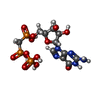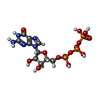+ Open data
Open data
- Basic information
Basic information
| Entry | Database: PDB / ID: 6e7c | |||||||||
|---|---|---|---|---|---|---|---|---|---|---|
| Title | 14-pf 3-start GMPCPP-human alpha1B/beta2B microtubules | |||||||||
 Components Components |
| |||||||||
 Keywords Keywords | STRUCTURAL PROTEIN / cytoskeleton / microtubules / recombinant human tubulin / tubulin isotype | |||||||||
| Function / homology |  Function and homology information Function and homology informationPost-chaperonin tubulin folding pathway / Cilium Assembly / cytoskeleton-dependent intracellular transport / Microtubule-dependent trafficking of connexons from Golgi to the plasma membrane / Carboxyterminal post-translational modifications of tubulin / Intraflagellar transport / Sealing of the nuclear envelope (NE) by ESCRT-III / Formation of tubulin folding intermediates by CCT/TriC / embryonic brain development / Gap junction assembly ...Post-chaperonin tubulin folding pathway / Cilium Assembly / cytoskeleton-dependent intracellular transport / Microtubule-dependent trafficking of connexons from Golgi to the plasma membrane / Carboxyterminal post-translational modifications of tubulin / Intraflagellar transport / Sealing of the nuclear envelope (NE) by ESCRT-III / Formation of tubulin folding intermediates by CCT/TriC / embryonic brain development / Gap junction assembly / Prefoldin mediated transfer of substrate to CCT/TriC / Kinesins / positive regulation of axon guidance / COPI-independent Golgi-to-ER retrograde traffic / Assembly and cell surface presentation of NMDA receptors / COPI-dependent Golgi-to-ER retrograde traffic / Recycling pathway of L1 / RHOH GTPase cycle / RHO GTPases activate IQGAPs / microtubule-based process / Hedgehog 'off' state / intercellular bridge / COPI-mediated anterograde transport / Activation of AMPK downstream of NMDARs / cytoplasmic microtubule / Mitotic Prometaphase / EML4 and NUDC in mitotic spindle formation / MHC class II antigen presentation / cellular response to interleukin-4 / Recruitment of NuMA to mitotic centrosomes / HSP90 chaperone cycle for steroid hormone receptors (SHR) in the presence of ligand / Resolution of Sister Chromatid Cohesion / Translocation of SLC2A4 (GLUT4) to the plasma membrane / RHO GTPases Activate Formins / cerebral cortex development / PKR-mediated signaling / modulation of chemical synaptic transmission / structural constituent of cytoskeleton / microtubule cytoskeleton organization / Schaffer collateral - CA1 synapse / neuron migration / HCMV Early Events / Aggrephagy / The role of GTSE1 in G2/M progression after G2 checkpoint / mitotic spindle / Separation of Sister Chromatids / mitotic cell cycle / double-stranded RNA binding / microtubule cytoskeleton / Hydrolases; Acting on acid anhydrides; Acting on GTP to facilitate cellular and subcellular movement / microtubule / cilium / protein heterodimerization activity / cell division / GTPase activity / ubiquitin protein ligase binding / GTP binding / structural molecule activity / metal ion binding / nucleus / cytoplasm Similarity search - Function | |||||||||
| Biological species |  Homo sapiens (human) Homo sapiens (human) | |||||||||
| Method | ELECTRON MICROSCOPY / helical reconstruction / cryo EM / Resolution: 3.65 Å | |||||||||
 Authors Authors | Ti, S.C. / Alushin, G.M. / Kapoor, T.M. | |||||||||
| Funding support |  United States, 2items United States, 2items
| |||||||||
 Citation Citation |  Journal: Dev Cell / Year: 2018 Journal: Dev Cell / Year: 2018Title: Human β-Tubulin Isotypes Can Regulate Microtubule Protofilament Number and Stability. Authors: Shih-Chieh Ti / Gregory M Alushin / Tarun M Kapoor /  Abstract: Cell biological studies have shown that protofilament number, a fundamental feature of microtubules, can correlate with the expression of different tubulin isotypes. However, it is not known if ...Cell biological studies have shown that protofilament number, a fundamental feature of microtubules, can correlate with the expression of different tubulin isotypes. However, it is not known if tubulin isotypes directly control this basic microtubule property. Here, we report high-resolution cryo-EM reconstructions (3.5-3.65 Å) of purified human α1B/β3 and α1B/β2B microtubules and find that the β-tubulin isotype can determine protofilament number. Comparisons of atomic models of 13- and 14-protofilament microtubules reveal how tubulin subunit plasticity, manifested in "accordion-like" distributed structural changes, can accommodate distinct lattice organizations. Furthermore, compared to α1B/β3 microtubules, α1B/β2B filaments are more stable to passive disassembly and against depolymerization by MCAK or chTOG, microtubule-associated proteins with distinct mechanisms of action. Mixing tubulin isotypes in different proportions results in microtubules with protofilament numbers and stabilities intermediate to those of isotypically pure filaments. Together, our findings indicate that microtubule protofilament number and stability can be controlled through β-tubulin isotype composition. | |||||||||
| History |
|
- Structure visualization
Structure visualization
| Movie |
 Movie viewer Movie viewer |
|---|---|
| Structure viewer | Molecule:  Molmil Molmil Jmol/JSmol Jmol/JSmol |
- Downloads & links
Downloads & links
- Download
Download
| PDBx/mmCIF format |  6e7c.cif.gz 6e7c.cif.gz | 162.8 KB | Display |  PDBx/mmCIF format PDBx/mmCIF format |
|---|---|---|---|---|
| PDB format |  pdb6e7c.ent.gz pdb6e7c.ent.gz | 125.7 KB | Display |  PDB format PDB format |
| PDBx/mmJSON format |  6e7c.json.gz 6e7c.json.gz | Tree view |  PDBx/mmJSON format PDBx/mmJSON format | |
| Others |  Other downloads Other downloads |
-Validation report
| Summary document |  6e7c_validation.pdf.gz 6e7c_validation.pdf.gz | 1.4 MB | Display |  wwPDB validaton report wwPDB validaton report |
|---|---|---|---|---|
| Full document |  6e7c_full_validation.pdf.gz 6e7c_full_validation.pdf.gz | 1.4 MB | Display | |
| Data in XML |  6e7c_validation.xml.gz 6e7c_validation.xml.gz | 41.6 KB | Display | |
| Data in CIF |  6e7c_validation.cif.gz 6e7c_validation.cif.gz | 58 KB | Display | |
| Arichive directory |  https://data.pdbj.org/pub/pdb/validation_reports/e7/6e7c https://data.pdbj.org/pub/pdb/validation_reports/e7/6e7c ftp://data.pdbj.org/pub/pdb/validation_reports/e7/6e7c ftp://data.pdbj.org/pub/pdb/validation_reports/e7/6e7c | HTTPS FTP |
-Related structure data
| Related structure data |  8998MC  8997C  6e7bC C: citing same article ( M: map data used to model this data |
|---|---|
| Similar structure data |
- Links
Links
- Assembly
Assembly
| Deposited unit | 
|
|---|---|
| 1 |
|
- Components
Components
| #1: Protein | Mass: 47917.977 Da / Num. of mol.: 1 Source method: isolated from a genetically manipulated source Source: (gene. exp.)  Homo sapiens (human) / Gene: TUBB2B / Production host: Homo sapiens (human) / Gene: TUBB2B / Production host:  Trichoplusia ni (cabbage looper) / References: UniProt: Q9BVA1 Trichoplusia ni (cabbage looper) / References: UniProt: Q9BVA1 | ||||
|---|---|---|---|---|---|
| #2: Protein | Mass: 48665.027 Da / Num. of mol.: 1 Source method: isolated from a genetically manipulated source Source: (gene. exp.)  Homo sapiens (human) / Gene: TUBA1B / Production host: Homo sapiens (human) / Gene: TUBA1B / Production host:  Trichoplusia ni (cabbage looper) / References: UniProt: P68363 Trichoplusia ni (cabbage looper) / References: UniProt: P68363 | ||||
| #3: Chemical | | #4: Chemical | ChemComp-G2P / | #5: Chemical | ChemComp-GTP / | |
-Experimental details
-Experiment
| Experiment | Method: ELECTRON MICROSCOPY |
|---|---|
| EM experiment | Aggregation state: HELICAL ARRAY / 3D reconstruction method: helical reconstruction |
- Sample preparation
Sample preparation
| Component | Name: 14-pf 3-start GMPCPP-human alpha1B/beta2B microtubule decorated with kinesin-1 motor domain Type: COMPLEX / Entity ID: #1-#2 / Source: RECOMBINANT |
|---|---|
| Molecular weight | Experimental value: NO |
| Source (natural) | Organism:  Homo sapiens (human) Homo sapiens (human) |
| Source (recombinant) | Organism:  Trichoplusia ni (cabbage looper) Trichoplusia ni (cabbage looper) |
| Buffer solution | pH: 6.8 |
| Specimen | Embedding applied: NO / Shadowing applied: NO / Staining applied: NO / Vitrification applied: YES / Details: Pseudo-helical microtubule lattice |
| Specimen support | Details: unspecified |
| Vitrification | Instrument: FEI VITROBOT MARK IV / Cryogen name: ETHANE |
- Electron microscopy imaging
Electron microscopy imaging
| Experimental equipment |  Model: Titan Krios / Image courtesy: FEI Company |
|---|---|
| Microscopy | Model: FEI TITAN KRIOS |
| Electron gun | Electron source:  FIELD EMISSION GUN / Accelerating voltage: 300 kV / Illumination mode: FLOOD BEAM FIELD EMISSION GUN / Accelerating voltage: 300 kV / Illumination mode: FLOOD BEAM |
| Electron lens | Mode: BRIGHT FIELD / Cs: 2.7 mm / C2 aperture diameter: 100 µm |
| Image recording | Average exposure time: 0.2 sec. / Electron dose: 1.6 e/Å2 / Detector mode: SUPER-RESOLUTION / Film or detector model: GATAN K2 SUMMIT (4k x 4k) |
| Image scans | Movie frames/image: 50 / Used frames/image: 2-50 |
- Processing
Processing
| EM software |
| ||||||||||||||||||||||||||||||||||||
|---|---|---|---|---|---|---|---|---|---|---|---|---|---|---|---|---|---|---|---|---|---|---|---|---|---|---|---|---|---|---|---|---|---|---|---|---|---|
| CTF correction | Type: PHASE FLIPPING AND AMPLITUDE CORRECTION | ||||||||||||||||||||||||||||||||||||
| Helical symmerty | Angular rotation/subunit: -25.71 ° / Axial rise/subunit: 8.759 Å / Axial symmetry: C1 | ||||||||||||||||||||||||||||||||||||
| 3D reconstruction | Resolution: 3.65 Å / Resolution method: FSC 0.143 CUT-OFF / Num. of particles: 46624 / Symmetry type: HELICAL | ||||||||||||||||||||||||||||||||||||
| Atomic model building | Protocol: FLEXIBLE FIT | ||||||||||||||||||||||||||||||||||||
| Atomic model building | PDB-ID: 3JAT Accession code: 3JAT / Source name: PDB / Type: experimental model |
 Movie
Movie Controller
Controller



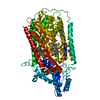




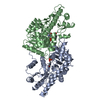

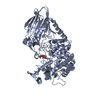


 PDBj
PDBj





























